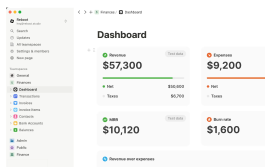Running a successful phone repair shop in 2025 starts with understanding your numbers.
Research shows that businesses tracking their goals are far more likely to achieve them, with 41% hitting all their targets. That’s not just luck — it’s strategy.
Tracking the right phone repair shop metrics gives you real-time insights into your shop’s performance, helping guide your business plans, reduce repair costs, and improve customer service.
So, which metrics matter most for the phone repair industry? Here are four essential ones you should be tracking in 2025 — and how they can drive your store’s success.
1. Average Repair Turnaround Time
Your customers expect speedy repairs paired with excellent service, and your business’ success depends on how many devices you can repair each day. Monitoring your average repair turnaround time gives you valuable insight into how quickly you can resolve a customer’s repair needs.
How to track this metric: Use your point of sale (POS) system’s repair tracker to measure the average time a device spends in your shop. Calculate it from the moment the customer drops it off to the time and hour it’s ready for pickup.
How to improve this metric: Identify potential bottlenecks, such as parts unavailability, diagnostics delays, or inefficient workflow management. Setting up automatic part ordering in the inventory manager, organizing the repair shop, and keeping the equipment in proper working order can help keep turnaround times low.
Why it matters: The quicker you complete repairs, the happier your customers will be — and the more likely they’ll recommend your services to family and friends.
2. Customer Satisfaction Score
One of the most important phone repair shop metrics any successful business needs to know is exactly how satisfied the customer is. After all, you don’t just want to repair their devices quickly — you want to be sure they’re happy with your repairs.
How to track this metric: The best way to turn customer satisfaction into a measurable metric is to encourage your customers to give feedback. Implement surveys, ask customers to rate your services, or simply invite them to leave reviews on the platform of your choice. You can also infer customer satisfaction and dissatisfaction from other metrics, such as repeat business rates or customer complaints.
How to improve this metric: Provide timely notifications to keep your customers informed throughout the repair process, ensure transparency with a transparent pricing structure, and deliver high-quality repairs. Focus on maintaining open communication while reducing the need for repeat visits.
Why it matters: A high customer satisfaction score will be reflected in the number of positive reviews your business receives. It improves trust, credibility, and both repeat business and new customer acquisition rates. It’s an all-around indicator of your phone repair business’ health.
3. Average Profit per Repair
Every repair requires time, resources, and spare parts, making tracking your average profit per repair (PPR) essential. This is a critical phone repair shop metric for evaluating the profitability of each repair ticket.
Your average PPR is typically calculated over a set period, such as monthly or quarterly, allowing you to compare your shop’s profitability over time.
How to track this metric: Start by calculating the total revenue from all repairs completed in the past month. Next, subtract the total costs and expenses. Finally, divide the result by the number of repairs performed that month. A positive outcome means you’ve made a profit, while a negative one signals a deficit.
For example, let’s say your phone shop has made 140 repairs, generating $25,000 of revenue in January. If the total expenses for the same month are $18,000, you’ve made $7,000 of profit in January. Divide 7,000 by 140 to obtain an average profit per repair of $50.
How to improve this metric: Review your pricing structure and verify you charge enough for each repair service to generate a profit. Negotiate deals with suppliers to lower the costs of ordering new parts and focus on high-margin repairs, like screen or battery services.
Consider upselling your customers with accessories like phone cases, screen protectors, or portable battery chargers. These sales can help you increase repair cost revenue and boost the average PPR further.
Why it matters: This metric provides a clear picture of your cell phone repair shop’s profitability, while highlighting potential cost inefficiencies. For instance, if your average PPR is low, it might suggest that you’re not charging enough for your services or are overspending on resources for each repair.
4. Lead Conversion Rate
Another vital phone repair shop metric is your lead conversion rate (LCR). This metric shows how effectively your phone repair business turns leads, from in-person inquiries, phone calls, or website visits, into paying customers.
How to track this metric: Use your POS system’s customer relationship management (CRM) tools to track each lead and when they convert into paying customers. The LCR equals the number of conversions divided by the number of leads.
For example, if your business generated 250 leads in January: 75 customer walk-ins, 50 emails, 50 phone calls, and 75 inquiries through your website. Of these 250 leads, 100 led to purchases, converting these leads into paying customers. Your lead conversion rate is 40%: 100 divided by 250.
How to improve this metric: Respond promptly to customer inquiries, follow up with emails and reminder texts if leads don’t convert right away, and step up your shop’s marketing efforts. You can also showcase reviews and testimonials to attract customers with positive feedback.
Why it matters: Boosting your LCR increases the percentage of visitors who become paying customers. A higher LCR leads to a more successful phone repair shop and gives you a competitive advantage in your industry.
Track All Your Phone Repair Shop Metrics With CellSmart POS
Tracking the right phone repair shop metrics in 2025 puts you ahead of the competition — and CellSmart POS gives you the tools to make it happen. With powerful reporting features, you can monitor revenue, repair trends, customer behavior, and more to keep your shop running efficiently and profitably.
Why wait to see your data in action? Request a demo today and let CellSmart POS help you thrive in 2025!



